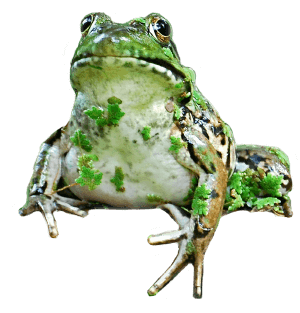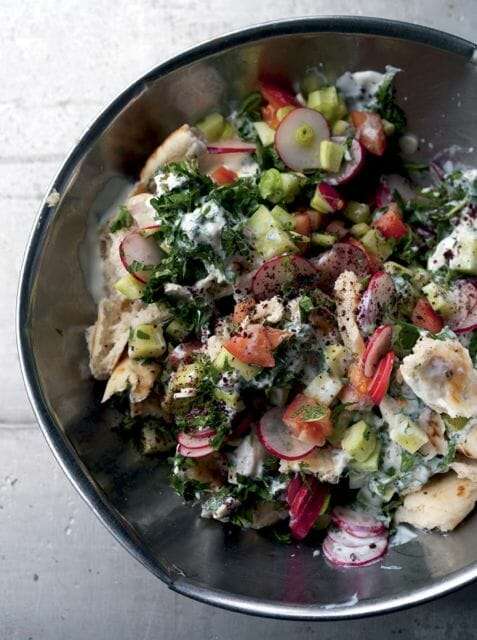in ‘jerusalem: a cookbook,’ a world of contrasts in every dish (a giveaway)
I CRAVE A SALAD—but one with something more substantial, not just greens. I’d also love an escape (too many garden chores screaming for attention—get me out of here!), but then I remember: I hate to travel. Thankfully, I have found comforting solutions on both scores in a book I bought last fall, “Jerusalem: A Cookbook” by Yotam Ottolenghi and Sami Tamini, an intimate journey through a cultural fusion of traditions and tastes. I’m making fattoush for lunch–the recipe is on the jump–and offering you two “tickets” to “Jerusalem,” too, in the latest cookbook giveaway.
The book’s collaborators grew up in the city—Yotam in the Jewish west area, Sami in the Muslim east—though neither has lived there for 20-plus years.
“The flavors and smells of this city are our mother tongue,” the London-based pair says in the cookbook’s introduction, acknowledging that they include traditional recipes, interpretations of traditional recipes, and also concoctions that draw on the culture’s gestalt but are theirs alone.
What I love most: Through the lens of these two master foodies, I’m looking at familiar vegetables (though the book is rich with meats and fishes, too) as if they are completely new. Example: a Kohlrabi Salad (with mint and cress and garlic, and a dressing laced with mascarpone and sour cream). The most common Allium in my pantry could become Stuffed Onions (with rice, pine nuts, species and herbs, and a secret ingredient: pomegranate molasses). I have been waiting impatiently since I got the book late last fall till there are fresh figs to combine with sweet potatoes into Roasted Sweet Potatoes and Fresh Figs (one of the most popular dishes, apparently, at the Ottolenghi restaurants in London). And I am certain my first tomatoes will find their way into Tomato and Sourdough Soup—so brilliantly simple-sounding, I can’t resist. A whole condiment section at the back of the book includes pickles and sauces, from preserved lemons to tahini (which I plan to use on the “Jerusalem: A Cookbook” take on falafel.)
For now, though, while I wait for each harvest in its time—the spirit of the cookbook, like that of the city it honors, is to eat seasonally and locally—there is that more-than-a-salad salad I’ve been craving.
And here it is: Na’ama’s Fattoush, a chopped salad with bread and a yogurty-or-buttermilk dressing that could variously be called Arab salad or Israeli salad–like so many recipes in “Jerusalem,” the provenance is impossible to pin down. (Na’ama, whose influence is felt elsewhere in the book as well, is Sami’s mother.)
Na’ama’s fattoush
(recipe from “Jerusalem: A Cookbook,” copyright Yotam Ottolenghi and Sami Tamimi; photos by Jonathan Lovekin.)
ingredients
- scant 1 cup / 200 g Greek yogurt and cup plus 2 tbsp / 200 ml whole milk, or 1 cups / 400 ml buttermilk (replacing both yogurt and milk)
- 2 large stale Turkish flatbread or naan (9 oz / 250 g in total)
- 3 large tomatoes (13 oz / 380 g in total), cut into -inch / 1.5cm dice
- 3 oz / 100 g radishes, thinly sliced
- 3 Lebanese or mini cucumbers (9 oz / 250 g in total), peeled and chopped into -inch / 1.5cm dice
- 2 green onions, thinly sliced
- oz / 15 g fresh mint
- scant 1 oz / 25 g flat-leaf parsley, coarsely chopped
- 1 tbsp dried mint
- 2 cloves garlic, crushed
- 3 tbsp freshly squeezed lemon juice
- 1/4 cup / 60 ml olive oil, plus extra to drizzle
- 2 tbsp cider or white wine vinegar
- tsp freshly ground black pepper
- 1 tsp salt
- 1 tbsp sumac or more to taste, to garnish
steps:
If using yogurt and milk, start at least 3 hours and up to a day in advance by placing both in a bowl. Whisk well and leave in a cool place or in the fridge until bubbles form on the surface. What you get is a kind of homemade buttermilk, but less sour.
Tear the bread into bite-size pieces and place in a large mixing bowl. Add your fermented yogurt mixture or commercial buttermilk, followed by the rest of the ingredients, mix well, and leave for 10 minutes for all the flavors to combine.
Spoon the fattoush into serving bowls, drizzle with some olive oil, and garnish generously with sumac.
how to win a copy of ‘jerusalem’
I PURCHASED two extra copies of “Jerusalem: A Cookbook,” to share with you. All you have to do to enter is answer this question in the comments below:
If the “Jerusalem” authors call that city’s flavors and traditions their “own culinary DNA,” what is the source of DNA that shows up in some favorite dishes from your kitchen? Any heritage in evidence—any hand-me-downs or traditions (even if they’re adopted ones)?
My answer is no literal DNA remains. My parents cooked—but from “The New York Times” cookbook, all aspirational-style things we two little girls turned our noses up at. My one grandmother was more “Joy of Cooking”-style. Nothing ethnic–unless you count kippered herrings for breakfast (ugh!) that my English-born grandfather who lived with us insisted upon once-weekly, a tradition I was happy to free myself from at the soonest opportunity to fly the coop.
Don’t worry if you’re feeling shy, or have no particular answer. Just say, “Count me in” or some such, and I will. Two winners will be chosen at random after entries close at midnight on Monday, April 15. Good luck to all.
(Disclosure: Purchases via Amazon affiliate links yield a small commission that I use to buy more books for future giveaways.)







There’s a bit of culinary DNA that I may have inherited from my maternal grandmother, though it is mostly contained in a Kochbuch – recipes and menus, all hand-written in spidery writing that nobody can seem to translate! She was Austrian, and was a cook in the Austrian Embassy, so traveled with the family to many interesting cities. This was in the late 19th Century. When she landed in the States, things were different. According to my mom, she never cooked anything special, saying that she couldn’t find good-enough ingredients!
My own cooking has been based on Hungarian-style cuisine. My husband was actually glad I didn’t know much about cooking! On our honeymoon, he bought me a Hungarian cookbook, and I learned to cook what he liked to eat. Both of our daughters serve paprika-laden dishes too, and we’ve enjoyed sharing our recipes and techniques through the years.
As for the Jerusalem cookbook, I’d love to check it out! One of our favorite cafes here is the Jerusalem Cafe, and it is well-known in the area.
I’d love to be considered for this book. The reference to DNA is difficult to answer. My mother was not a great cook but she did make some delicious Italian dishes that she learned from my father’s family. I learned to cook and bake on my own by watching others, reading cookbooks and just experimenting with fresh, local ingredients. My approach is less is more esp when you use the best ingredients you can.
I have been wanting Jerusalem. It speaks to some of my food DNA. My father is from Provence, my paternal grandparents from Piedmonte, Italy and Armenia, respectively. I learned to cook from them all. My mother is a true New Yorker (Welsh, English), of the Ingall’s family. Between the varied cultures I was raised in I have a passion for big organic gardens, my small homestead with chickens, old techniques of food preservation, an very middle eastern cooking. Pomegranate molasses, zatar, and dukkah are mainstays of my kitchen.
THE GIVEAWAY IS NOW CLOSED, but you are welcome to continue to share your comments anytime. Winners are being notified by email.
mine I believe is borrowed DNA…having loved the foods of so many different places for so long…mildly envious of friends who had special foods for holidays and special events…what joy to cook Turkish borek or bake a Greek Easter bread…pat out a tortilla or slow cook an African ground nut stew…my mother was a simple cook, but gave me the world thru the sentence, “Let’s try…..”
My kitchen has been totally reinvented from my mother’s kitchen. She cooked the same basic recipes on a two week cycle, never wavering from the predictable. I enjoy trying new recipes and ingredients, and have improved the overall health of my family by using more vegetables and fruits in my cooking.